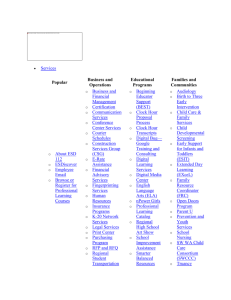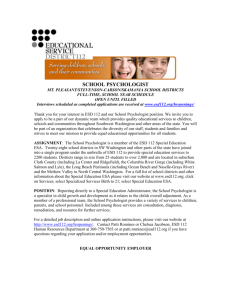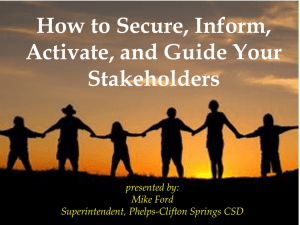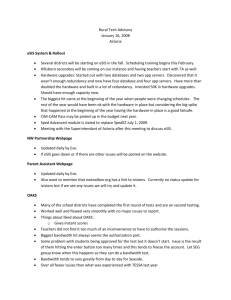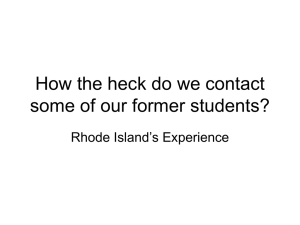Effective Practices in Educational Advocacy
advertisement
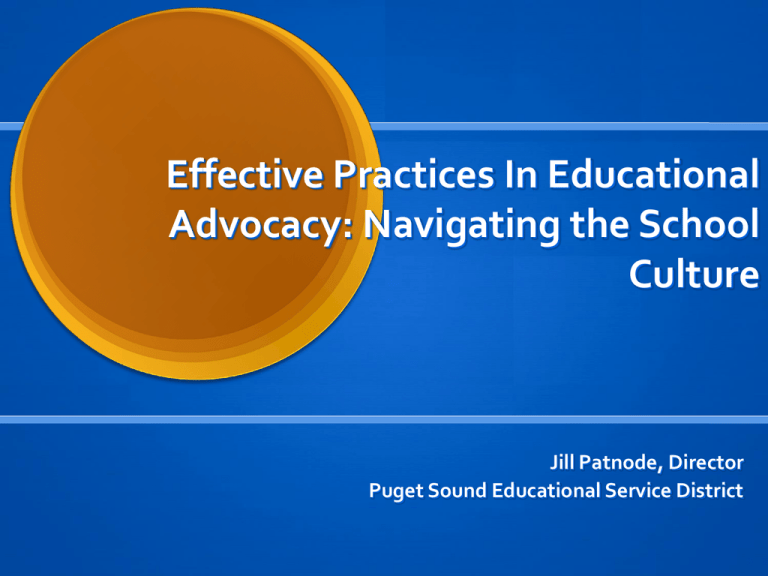
Effective Practices In Educational Advocacy: Navigating the School Culture Jill Patnode, Director Puget Sound Educational Service District One-fifth of all 16-24 year-olds in south King County are disconnected from school and work 20,000 Opportunity Youth The majority are poor youth of color. There are many sub-groups, with varying assets & needs: English Language Learners Homeless Foster Youth CourtInvolved Teen Parents Undocumented a partner of the King County System Integration Initiative The PathNet Initiative WHAT: The PathNet Initiative is a regional and state model of service delivery that reengages juvenile justice involved out-of-school youth through best practices in systems integration and interagency collaboration. HOW: Access and connection to a seamless network of services that support and advance education and employment goals. King County Systems Integration Initiative (KC-SII): Uniting for Youth Group of state and local youth-serving agencies Improve the coordination and integration of services for youth involved in multiple systems Uniting for Youth Partners Juvenile Court (King County Superior Court) Children’s Administration, Region 4, DCFS King County Department of Community & Human Services (Mental Health, Chemical Dependency, Public Defense) Puget Sound Educational Service District Department of Adult and Juvenile Detention Casey Family Programs (Seattle Field Office) Juvenile Rehabilitation Administration, Region 4 Attorney General’s Office, Seattle Social and Health Services Division King County Office of Management and Budget Opportunity Youth Action Plan The focus is building a robust, coordinated, diverse system of re-engagement pathways designed to help youth and young adults reconnect to education and progress towards a college or career credential and living-wage work. Cornerstones of PathNet A current strength-based assessment A student-driven plan Connectivity to the right educational/vocational program for that student Care Manager Uniting for Youth: Purpose and Goals Improve outcomes for children, youth and families by: Promoting increased cooperation and coordination among staff from different systems Achieving and institutionalizing greater multi-system coordination and integration at the policy level Networking question #1 Care Manager: -Why do you “care” about this population? -What are the characteristics of an effective “care manager” that is able to provide individualized supports to opportunity youth? Networking question #2 Strength based assessments: Describe how you “flip” deficit assessments into a strength-based approach and/or share any strength based assessments you use. Networking question #3 Student Driven Plan: -Describe the plan/assessment your agency uses? -Is it formal or informal? -What are the plan components? -Process for monitoring and evaluation of plan? Education OFFICE OF SUPERINTENDENT OF PUBLIC INSTRUCTION (OSPI) Olympia, Washington ESD 101 Spokane ESD 105 Yakima ESD 123 Pasco 59 Districts 23 Districts ESD 112 Vancouver North Central ESD 171, Wenatchee 25 Districts 29 Districts 30 Districts ESD 113 Olympia Northwest ESD 189, Anacortes 35 Districts Olympic ESD 114, Bremerton Puget Sound ESD 121, Renton 45 Districts 35 Districts 15 Districts Right to a Free and Public Education All students have this right Birth Certificate and Immunization Proof of Citizenship or Immigration Status NOT needed Ready to Learn Schools invest a great deal of time and money in Curricula delivery Staff development Policies and procedures Testing Special Education Tiered interventions Everything they do is designed to support a 100% graduation rate. They are limited by time and resources. Graduation Requirements 20-24 Credits: District Specific until 2016 High School and Beyond Plan Culminating Project State Exams Reading and Writing High School Proficiency (MSPE & HSPE) Math EOC (End of Course) Multi-Tiered Systems of Support (MTSS) Suicide Trauma at School Substance Abuse Drop Out Failing Academic Expectations Highest Risk Students Fighting –Threats Anti-Social Behavior Experimenting with Alcohol/ Drugs Depression – Isolation Absenteeism Minimal Interest in School Homework not completed Falling Behind on Benchmarks Some Students At-Risk Respect for Self Respect For Others Respect for Property Engaged in School In School Reading Engaged in Learning Consistent Academic Progress High Expectations – All Students Learning Support Academic School Based Intervention Resources Title IX McKinney Vento Becca Truancy Court School Counselors: ASCA Model Disaster Preparedness/Emergency Response Planning School Nurse/Health Services Substance Abuse/Mental Health Health Curricula Family and Community Engagement Before/after school Programs Social Workers, Family Liaisons Parent Engagement Extra Curricular: Scheduled Play! Community Resources Coordinating Student Assistance: Working Together to Help Students Learn School Policy Integration with other school based programs Staff Development Family/Community Collaboration Program Awareness Internal Referral Process Program Evaluation Student Assistance Team Learning their language… Educational Behaviors Educational Outcomes attendance/truancy unsafe behavior behavioral problems disciplinary action Suspensions/expulsions parental involvement "lost days of learning" seat time Disengaged students Tiered intervention grades standardized tests skill development grade promotion/retention graduation rates higher education Adequate yearly progress Higher order thinking How Do I Advocate For My Client? (inside the school district) Professional closest to the student (teacher, therapist, etc.) Principal (CEO of the school house) Special Education Coordinator or Director Executive Director or Assistant Superintendent Superintendent How do I advocate for my client? (outside the school district) Puget Sound Educational Service District Parent Support Groups Office of the Education Ombuds Advocacy Groups (ex. League of Education Voters) Legal Services (ex. Team Child; Colombia Legal Services) Points of Access Discipline Academics Behavioral Vice Principal Counselors School Security Specialists Principal King County Resource Guide Information Sharing Information Sharing FERPA Education Records Directory Information Personal Observations Rhythms of a School Year UCLA Mental Health in Schools http://smhp.psych.ucla.edu/ August: Prevent burnout by planning ahead September: Getting a good start (transitions; welcomes; open houses) October: Enabling School Adjustment (early identification; classroom strategies) November: Responding to referrals (interventions; end of quarter; conferences) December: Re-engaging students (burn-out; opportunities for improvement; anticipation) January: A time for renewal and new starts (end of semester report cards; interventions; self efficacy; ) February: Mid-point March: Reducing stress and burnout (compassion fatigue; budgets; planning for next school year professional development; end of quarter; next year registration) April: Spring is a high risk time (proms; spring fever; spring break; prevention activities; conferences*; release of Healthy Youth Survey) May: Planning for new transitions (statewide testing*) June: Summer and the living ain’t easy July: Reports and Planning (principals and admin are in schools finalizing details of upcoming school year Resources Student Assistance Prevention Intervention Manual Educational Advocate Program Manual (PSESD & Team Child) Educating Youth in Adult Jails FACEBOOK: Educational Advocate Program Eligibility: • • • • Less than 21 but at least 16 by September 1 Have NOT graduated from HS AND Be significantly behind in credits OR Be recommended for enrollment by professionals from DSHS, JJ, District approved personnel or staff from agencies who provide educational advocacy services. The 4th Cornerstone Connectivity to the right educational /vocational program In 2 minutes or less share about your agency (consider sharing target audience, location, mission, resources, how to refer, orientation dates)
